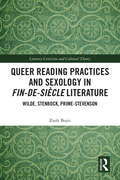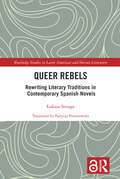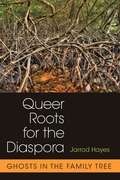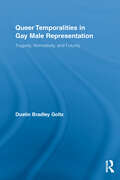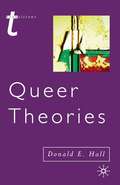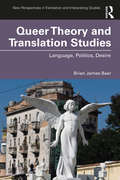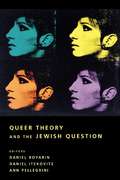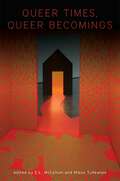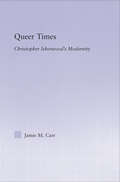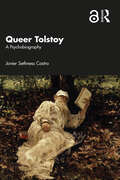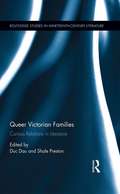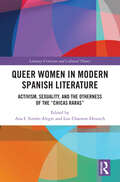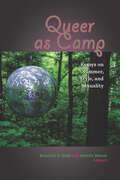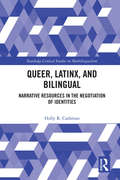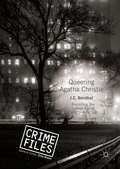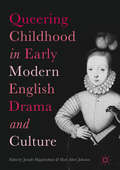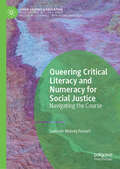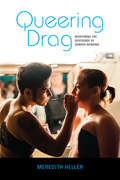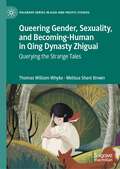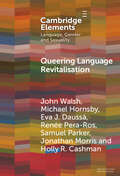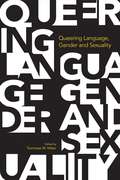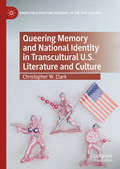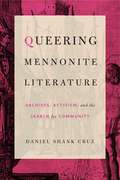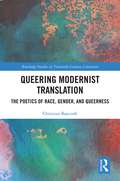- Table View
- List View
Queer Reading Practices and Sexology in Fin-de-Siècle Literature: Wilde, Stenbock, Prime-Stevenson (Literary Criticism and Cultural Theory)
by Zsolt BojtiThis book scrutinises the production and transnational distribution of sexological knowledge at the turn of the century. The works of three transnationally mobile authors are in the focus: The Picture of Dorian Gray (1890/1891) and Teleny (1893) by, and attributed to, Oscar Wilde; ‘The True Story of a Vampire’ (1894) by Count Stanislaus Eric Stenbock; and Imre: A Memorandum (1906) by Edward Prime-Stevenson. The textual analysis is governed by references in all four works to Hungarian culture to demonstrate how they conceptualised ‘Hungarianness’ and same-sex desire simultaneously in the light of the new classificatory science of sexualities coming from German-speaking Central Europe. By foregrounding a timely literary angle and a ‘culturalist’ approach, this book offers non-Anglocentric insights, not bound by either language or nationality, to shed new light on the interdisciplinary reading practices of late-Victorian subjects and the ways they contributed to the emergence of fin-de-siècle queer fiction.
Queer Rebels: Rewriting Literary Traditions in Contemporary Spanish Novels (Routledge Studies in Latin American and Iberian Literature)
by Łukasz SmugaQueer Rebels is a study of gay narrative writings published in Spain at the turn of the 20th century. The book scrutinises the ways in which the literary production of contemporary Spanish gay authors – José Luis de Juan, Luis G. Martín, Juan Gil-Albert, Juan Goytisolo, Eduardo Mendicutti, Luis Antonio de Villena and Álvaro Pombo – engages with homophobic and homophile discourses, as well as with the vernacular and international literary legacy. The first part revolves around the metaphor of a rebellious scribe who queers literary tradition by clandestinely weaving changes into copies of the books he makes. This subversive writing act, named ‘Mazuf’s gesture’ after the protagonist of José Luis de Juan’s This Breathing World (1999), is examined in four highly intertextual works by other writers. The second part of the book explores Luis Antonio de Villena and Álvaro Pombo, who in their different ways seek to coin their own definitions of homosexual experience in opposition both to the homophobic discourses of the past and to the homonormative regimes of the commercialised and trivialised gay culture of today. In their novels, ‘Mazuf’s gesture’ involves playing a sophisticated queer game with readers and their expectations.
Queer Roots for the Diaspora: Ghosts in the Family Tree
by Jarrod HayesEmploying rootedness as a way of understanding identity has increasingly been subjected to acerbic political and theoretical critiques. Politically, roots narratives have been criticized for attempting to police identity through a politics of purity--excluding anyone who doesn't share the same narrative. Theoretically, a critique of essentialism has led to a suspicion against essence and origins regardless of their political implications. The central argument of Queer Roots for the Diaspora is that, in spite of these debates, ultimately the desire for roots contains the "roots" of its own deconstruction. The book considers alternative root narratives that acknowledge the impossibility of returning to origins with any certainty; welcome sexual diversity; acknowledge their own fictionality; reveal that even a single collective identity can be rooted in multiple ways; and create family trees haunted by the queer others patrilineal genealogy seems to marginalize. The roots narratives explored in this book simultaneously assert and question rooted identities within a number of diasporas--African, Jewish, and Armenian. By looking at these together, one can discern between the local specificities of any single diaspora and the commonalities inherent in diaspora as a global phenomenon. This comparatist, interdisciplinary study will interest scholars in a diversity of fields, including diaspora studies, postcolonial studies, LGBTQ studies, French and Francophone studies, American studies, comparative literature, and literary theory.
Queer Temporalities in Gay Male Representation: Tragedy, Normativity, and Futurity (Routledge Studies in Rhetoric and Communication)
by Dustin Bradley GoltzThrough the analysis of over seventy films and thirty television series, ranging from Shortbus, Sweet Home Alabama, and Poseidon to Noah’s Arc, Brothers & Sisters, and Dawson’s Creek, Goltz examines reoccurring narrative structures in popular media that perpetuate the extreme value placed upon "young" gay male bodies, while devaluing health, aging, and longevity. Alienated from the future -- outside of limited and exclusionary systems of marriage and procreation -- the gay male is narrated within a circular tragedy that draws upon cultural mythologies of "older" gay male predation, the absence of gay intergenerational mentorship, and the gay male as sacrificial victim. Using a Burkean framework, Goltz makes a theoretical, rhetorical, and cultural investigation of how the increased visibility of "positive" gay representation in dominant media shapes contemporary meanings of gay aging, heteronormative future, homonormative future, and queer potential.
Queer Theories
by Donald E. HallThis essential introductory guide explores and aggressively expands the provocative new field of sexual identity studies. It explains the history of sexual identity categories, such as 'gay' and 'lesbian', covers the reclamation of 'queer' as a term of radical self-identification, and details recent challenges to sexual identity studies posed by transgender and bisexual theories. Donald E. Hall offers concrete applications of the abstract theories he explores, with imaginative new readings of such works as 'The Yellow Wallpaper', Dr Jekyll and Mr Hyde, Orlando and The Color Purple. Throughout, Hall urges the reader to grapple with the changing nature of sexual identity in the twenty-first century and asks searching questions about how we might identify ourselves differently given new technologies and new possibilities for sexual experimentation. To students, theorists and activists alike, Queer Theories issues a challenge to continue to disrupt narrow, traditional notions of sexual 'normality' and to resist setting up new and confining categories of 'true' sexual identity.
Queer Theory and Translation Studies: Language, Politics, Desire (New Perspectives in Translation and Interpreting Studies)
by Brian James BaerThis groundbreaking book explores the relevance of queer theory to Translation Studies and of translation to Global Sexuality Studies. Beginning with a comprehensive overview of the origins and evolution of queer theory, this book places queer theory and Translation Studies in a productive and mutually interrogating relationship. After framing the discussion of actual and potential interfaces between queer sexuality and queer textuality, the chapters trace the transnational circulation of queer texts, focusing on the place of translation in "gay" anthologies, the packaging of queer life writing for global audiences, and the translation of lyric poetry as a distinct site of queer performativity. Baer analyzes fictional translators in literature and film, the treatment of translation in historical and ethnographic studies of sexual and linguistic others, the work of queer translators, and the reception of queer texts in translation. Including a range of case studies to exemplify key ethical issues relevant to all scholars of global sexuality and postcolonial studies, this book is essential reading for advanced students, scholars, and researchers in Translation Studies, gender and sexuality studies, and related areas.
Queer Theory and the Jewish Question (Between Men-Between Women: Lesbian and Gay Studies)
by Daniel Boyarin Daniel Itzkovitz Ann PellegriniThe essays in this volume boldly map the historically resonant intersections between Jewishness and queerness, between homophobia and anti-Semitism, and between queer theory and theorizations of Jewishness. With important essays by such well-known figures in queer and gender studies as Judith Butler, Daniel Boyarin, Marjorie Garber, Michael Moon, and Eve Sedgwick, this book is not so much interested in revealing—outing—"queer Jews" as it is in exploring the complex social arrangements and processes through which modern Jewish and homosexual identities emerged as traces of each other during the last two hundred years.
Queer Times, Queer Becomings
by Mikko Tuhkanen E. L. McCallumIf queer theorists have agreed on anything, it is that for queer thought to have any specificity at all, it must be characterized by becoming, the constant breaking of habits. Queer Times, Queer Becomings explores queer articulations of time and becoming in literature, philosophy, film, and performance. Whether in the contexts of psychoanalysis, the nineteenth-century discourses of evolution and racial sciences, or the daily rhythms of contemporary, familially oriented communities, queerness has always been marked by a peculiar untimeliness, by a lack of proper orientation in terms of time as much as social norms. Yet it is the skewed relation to the temporal norm that also gives queerness its singular hope. This is demonstrated by the essays collected here as they consider the ways in which queer theory has acknowledged, resisted, appropriated, or refused divergent models of temporality.
Queer Times: Christopher Isherwood's Modernity (Studies in Major Literary Authors)
by Jamie M. CarrThis book maps Christopher Isherwood's intellectual and aesthetic reflections from the late 1930s through the late 1970s. Drawing on the queer theory of Eve Sedgwick and the ethical theory of Michel Foucault, Carr illuminates Isherwood's post-war development of a queer ethos through his focus on the aesthetic, social, and historical politics of the 1930s in his novels Prater Violet (1945), The World in the Evening (1954), and Down There on a Visit (1962), and in his memoir, Christopher and His Kind: 1929–1939 (1976).
Queer Tolstoy: A Psychobiography
by Javier Sethness CastroQueer Tolstoy is a multidimensional work combining psychoanalysis, political history, LGBTQ+ studies, sexology, ethics, and theology to explore the life and art of Count Lev Nikolaevich Tolstoy. Using a psychobiographical framework, Sethness Castro uncovers profoundly queer dimensions in Tolstoy’s life experiences and art. Deftly contributing to the progressive and radical analysis of gender and sexuality, this book examines how Tolstoy’s erotic dissidence informed his anarchist politics, anti-militarist ideals, and voluminous literary production. Sethness Castro analyzes the influence of Buddha, Socrates, Jesus, Cervantes, Rousseau, Kant, Herzen, Proudhon, Chernyshevsky, and his mother Marya Volkonskaya on the artist's writings. Furthermore, he details Tolstoy's emblematic linking of LGBTQ+ desire with moral and erotic self-determination and resistance to Tsarist despotism—especially in War and Peace. This book is vital reading for those interested in the intersection of literature, psychoanalysis, queer studies, and Russian history.
Queer Victorian Families: Curious Relations in Literature (Routledge Studies in Nineteenth Century Literature)
by Duc Dau Shale PrestonThe Victorians elevated the home and heteronormative family life to an almost secular religion. Yet alongside the middle-class domestic ideal were other families, many of which existed in the literature of the time. Queer Victorian Families: Curious Relations in Literature is chiefly concerned with these atypical or "queer" families. This collection serves as a corrective against limited definitions of family and is a timely addition to Victorian studies. Interdisciplinary in nature, the collection opens up new possibilities for uncovering submerged, marginalized, and alternative stories in Victorian literature. Broad in scope, subjects range from Count Fosco and his animal "children" in Wilkie Collins’s The Woman in White, to male kinship within and across Alfred Tennyson’s In Memoriam and Herman Melville’s Moby-Dick, and the nexus between disability and loving relationships in the fiction of Dinah Mulock Craik and Charlotte M. Yonge. Queer Victorian Families is a wide-ranging and theoretically adventurous exposé of the curious relations in the literary family tree.
Queer Women in Modern Spanish Literature: Activism, Sexuality, and the Otherness of the 'Chicas Raras' (Literary Criticism and Cultural Theory)
by Ana I. Simón-Alegre and Lou Charnon-DeutschThis original collection of essays explores the work and life choices of Spanish women who, through their writings and social activism, addressed social justice, religious dogmatism, the educational system, gender inequality, and tensions in female subjectivity. It brings together writers who are not commonly associated with each other, but whose voices overlap, allowing us to foreground their unconventionality, their relationships to each other, and their relation to modernity. The objective of this volume is to explore how the idea of "queerness" played an important role in the personal lives and social activism of these writers, as well as in the unconventional and nonconformist characters they created in their work. Together, the essays demonstrate that the concept of "queer women" is useful for investigating the evolution of women’s writing and sexual identity during the period of Spain’s fitful transition to modernity in the nineteenth century. The concept of queerness in its many meanings points to the idea of non-normativity and gender dissidence that encompasses how women intellectuals experienced friendship, religion, sex, sexuality, and gender. The works examined include autobiography, poetry, memoir, salon chronicles, short and long fiction, pedagogical essays, newspaper articles, theater, and letters. In addition to exploring the significant presence of queer women in nineteenth- and twentieth-century Spanish literature and culture, the essays examine the reasons why the voices of Spanish women authors have been culturally silenced. One thrust in this collection explores generational transitions of Spanish writers from the romantics and their "hermandad lírica" ("lyrical sisterhood") through to "las Sinsombrero" ("Women Without Hats"), and finally, current Spanish writers linked to the LGBTQ+ community.
Queer as Camp: Essays on Summer, Style, and Sexuality
by Kenneth B. Kidd Derritt MasonNamed the #1 Bestselling Non-Fiction Title by the Calgary HeraldTo camp means to occupy a place and/or time provisionally or under special circumstances. To camp can also mean to queer. And for many children and young adults, summer camp is a formative experience mixed with homosocial structure and homoerotic longing. In Queer as Camp, editors Kenneth B. Kidd and Derritt Mason curate a collection of essays and critical memoirs exploring the intersections of “queer” and “camp,” focusing especially on camp as an alternative and potentially nonnormative place and/or time. Exploring questions of identity, desire, and social formation, Queer as Camp delves into the diverse and queer-enabling dimensions of particular camp/sites, from traditional iterations of camp to camp-like ventures, literary and filmic texts about camp across a range of genres (fantasy, horror, realistic fiction, graphic novels), as well as the notorious appropriation of Indigenous life and the consequences of “playing Indian.” These accessible, engaging essays examine, variously, camp as a queer place and/or the experiences of queers at camp, including Vermont’s Indian Brook, a single-sex girls’ camp that has struggled with the inclusion of nonbinary and transgender campers and staff; the role of Jewish summer camp as a complicated site of sexuality, social bonding, and citizen-making as well as a potentially if not routinely queer-affirming place. They also attend to cinematic and literary representations of camp, such as the Eisner award-winning comic series Lumberjanes, which revitalizes and revises the century-old Girl Scout story; Disney’s Paul Bunyan, a short film that plays up male homosociality and cross-species bonding while inviting queer identification in the process; Sleepaway Camp, a horror film that exposes and deconstructs anxieties about the gendered body; and Wes Anderson’s critically acclaimed Moonrise Kingdom, which evokes dreams of escape, transformation, and other ways of being in the world. Highly interdisciplinary in scope, Queer as Camp reflects on camp and Camp with candor, insight, and often humor. Contributors: Kyle Eveleth, D. Gilson, Charlie Hailey, Ana M. Jimenez-Moreno, Kathryn R. Kent, Mark Lipton, Kerry Mallan, Chris McGee, Roderick McGillis, Tammy Mielke, Alexis Mitchell, Flavia Musinsky, Daniel Mallory Ortberg, Annebella Pollen, Andrew J. Trevarrow, Paul Venzo, Joshua Whitehead
Queer, Latinx, and Bilingual: Narrative Resources in the Negotiation of Identities (Routledge Critical Studies in Multilingualism)
by Holly CashmanShortlisted for the 2018 BAAL Book Prize This book is a sociolinguistic ethnography of LGBT Mexicans/Latinxs in Phoenix, Arizona, a major metropolitan area in the U.S. Southwest. The main focus of the book is to examine participants’ conceptions of their ethnic and sexual identities and how identities influence (and are influenced by) language practices. This book explores the intersubjective construction and negotiation of identities among queer Mexicans/Latinxs, paying attention to how identities are co-constructed in the interview setting in coming out narratives and in narratives of silence. The book destabilizes the dominant narrative on language maintenance and shift in sociolinguistics, much of which relies on a (heterosexual) family-based model of intergenerational language transmission, by bringing those individuals often at the margin of the family (LGBTQ members) to the center of the analysis. It contributes to the queering of bilingualism and Spanish in the U.S., not only by including a previously unstudied subgroup (LGBTQ people), but also by providing a different lens through which to view the diverse language and identity practices of U.S. Mexicans/Latinxs. This book addresses this exclusion and makes a significant contribution to the study of bilingualism and multilingualism by bringing LGBTQ Latinas/os to the center of the analysis.
Queering Agatha Christie
by J. C. BernthalThis book is the first fully theorized queer reading of a Golden Age British crime writer. Agatha Christie was the most commercially successful novelist of the twentieth century, and her fiction remains popular. She created such memorable characters as Hercule Poirot and Jane Marple, and has become synonymous with a nostalgic, conservative tradition of crime fiction. J. C. Bernthal reads Christie through the lens of queer theory, uncovering a playful, alert, and subversive social commentary. After considering Christie's emergence in a commercial market hostile to her sex, in Queering Agatha Christie Bernthal explores homophobic stereotypes, gender performativity, queer children, and masquerade in key texts published between 1920 and 1952. Christie engaged with debates around human identity in a unique historical period affected by two world wars. The final chapter considers twenty-first century Poirot and Marple adaptations, with visible LGBT characters, and poses the question: might the books be queerer?
Queering Childhood in Early Modern English Drama and Culture
by Jennifer Higginbotham Mark Albert JohnstonThis volume analyzes early modern cultural representations of children and childhood through the literature and drama of Shakespeare and his contemporaries. Contributors include leading international scholars of the English Renaissance whose essays consider asexuals and sodomites, roaring girls and schoolboys, precocious princes and raucous tomboys, boy actors and female apprentices, while discussing a broad array of topics, from animal studies to performance theory, from queer time to queer fat, from teaching strategies to casting choices, and from metamorphic sex changes to rape and cannibalism. The collection interrogates the cultural and historical contingencies of childhood in an effort to expose, theorize, historicize, and explicate the spectacular queerness of early modern dramatic depictions of children.
Queering Critical Literacy and Numeracy for Social Justice: Navigating the Course (Queer Studies and Education)
by Summer Melody PennellThis volume explores the value of using queer pedagogy in an interdisciplinary middle school classroom to promote a better understanding of social justice and the social construction of knowledge among students. In the course of the study, which combined student-centered literacy and mathematical inquiries through a social justice lens, students used critical literacy skills to research social justice topics, learned to read numerical data like traditional print text, and created and solved their own math problems. In bringing together critical mathematics and critical literacy through a queer lens, the author offers new ways of thinking that challenges norms and helps students embrace new concepts of learning for the modern era.
Queering Drag: Redefining the Discourse of Gender-Bending
by Meredith HellerTheatrical gender-bending, also called drag, is a popular form of entertainment and a subject of scholarly study. However, most drag studies do not question the standard words and ideas used to convey this performance genre. Drawing on a rich body of archival and ethnographic research, Meredith Heller illuminates diverse examples of theatrical gender-bending: male impersonation in variety and vaudeville (1860–1920); the "sexless" gender-bending of El Teatro Campesino (1960–1980); queer butch acts performed by black nightclub singers, such as Stormé DeLarverie, instigator of the Stonewall riots (1910–1970); and the range of acts that compose contemporary drag king shows. Heller highlights how, in each case, standard drag discourses do not sufficiently capture the complexity of performers' intents and methods, nor do they provide a strong enough foundation for holistically evaluating the impact of this work. Queering Drag offers redefinition of the genre centralized in the performer's construction and presentation of a "queer" version of hegemonic identity, and it models a new set of tools for analyzing drag as a process of intents and methods enacted to effect specific goals. This new drag discourse not only allows for more complete and accurate descriptions of drag acts, but it also facilitates more ethical discussions about the bodies, identities, and products of drag performers.
Queering Gender, Sexuality, and Becoming-Human in Qing Dynasty Zhiguai: Querying the Strange Tales (Palgrave Series in Asia and Pacific Studies)
by Melissa Shani Brown Thomas William WhykeThis book offers queer readings of Chinese Qing Dynasty zhiguai, ‘strange tales’, a genre featuring supernatural characters and events. In a unique approach interweaving Chinese philosophies alongside critical theories, this book explores tales which speak to contemporary debates around identity and power. Depictions of porous boundaries between humans and animals, transformations between genders, diverse sexualities, and contextually unusual masculinities and femininities, lend such tales to queer readings. Unlike previous scholarship on characters as allegorical figures or stories as morality tales, this book draws on queer theory, animal studies, feminism, and Deleuzian philosophy, to explore the ‘strange’ and its potential for social critique. Examining such tales enriches the scope of historic queer world literatures, offering culturally situated stories of relationships, desires, and ways of being, that both speak to and challenge contemporary debates.
Queering Language Revitalisation: Navigating Identity and Inclusion among Queer Speakers of Minority Languages (Elements in Language, Gender and Sexuality)
by John Walsh Michael Hornsby Eva J. Daussà Renée Pera-Ros Samuel Parker Jonathan Morris Holly R. CashmanThis Element aims to deepen our understanding of how the fields of multilingualism, second language acquisition and minority language revitalisation have largely overlooked the question of queer sexual identities among speakers of the languages under study. Based on case studies of four languages experiencing differing degrees of minoritisation – Irish, Breton, Catalan and Welsh – it investigates how queer people navigate belonging within the binary of speakers/non-speakers of minoritised languages while also maintaining their queer identities. Furthermore, it analyses how minoritised languages are dealing linguistically with the growing need for 'gender-fair' or 'gender-neutral' language. The marginalisation of queer subjects in these strands of linguistics can be traced to the historical dominance of the Fishmanian model of 'Reversing Language Shift' (RLS), which assumed the importance of the deeply heteronormative model of 'intergenerational transmission' of language as fundamental to language revitalisation contexts.
Queering Language: Gender and Sexuality
by Tommaso M. MilaniThis volume showcases ten years of research on language, gender and sexuality informed by queer theory. In line with a queer dislike for any normalizing discourse and practice, the book gives a multi-faceted set of applications of queer theoretical ideas to linguistic analysis.
Queering Memory and National Identity in Transcultural U.S. Literature and Culture (American Literature Readings in the 21st Century)
by Christopher W. ClarkThis book examines the queer implications of memory and nationhood in transcultural U.S. literature and culture. Through an analysis of art and photography responding to the U.S. domestic response to 9/11, Iraq war fiction, representations of Abu Ghraib and Guantánamo Bay, and migrant fiction in the twenty-first century, Christopher W. Clark creates a queer archive of transcultural U.S. texts as a way of destabilizing heteronormativity and thinking about productive spaces of queer world-building. Drawing on the fields of transcultural memory, queer studies, and transculturalism, this book raises important questions of queer bodies and subjecthood. Clark traces their legacies through texts by Sinan Antoon, Mohamedou Ould Slahi among others, alongside film and photography that includes artists such as Nina Berman and Hasan Elahi. In all, the book queers forms of cultural memory and national identity to uncover the traces of injury but also spaces of regeneration.
Queering Mennonite Literature: Archives, Activism, and the Search for Community
by Daniel Shank CruzThough the terms “queer” and “Mennonite” rarely come into theoretical or cultural contact, over the last several decades writers and scholars in the United States and Canada have built a body of queer Mennonite literature that shifts these identities into conversation. In this volume, Daniel Shank Cruz brings this growing genre into a critical focus, bridging the gaps between queer theory, literary criticism, and Mennonite literature.Cruz focuses his analysis on recent Mennonite-authored literary texts that espouse queer theoretical principles, including Christina Penner’s Widows of Hamilton House, Wes Funk’s Wes Side Story, and Sofia Samatar’s Tender. These works argue for the existence of a “queer Mennonite” identity on the basis of shared values: a commitment to social justice, a rejection of binaries, the importance of creative approaches to conflict resolution, and the practice of mutual aid, especially in resisting oppression. Through his analysis, Cruz encourages those engaging with both Mennonite and queer literary criticism to explore the opportunity for conversation and overlap between the two fields.By arguing for engagement between these two identities and highlighting the aspects of Mennonitism that are inherently “queer,” Cruz gives much-needed attention to an emerging subfield of Mennonite literature. This volume makes a new and important intervention into the fields of queer theory, literary studies, Mennonite studies, and religious studies.
Queering Mennonite Literature: Archives, Activism, and the Search for Community
by Daniel Shank CruzThough the terms “queer” and “Mennonite” rarely come into theoretical or cultural contact, over the last several decades writers and scholars in the United States and Canada have built a body of queer Mennonite literature that shifts these identities into conversation. In this volume, Daniel Shank Cruz brings this growing genre into a critical focus, bridging the gaps between queer theory, literary criticism, and Mennonite literature.Cruz focuses his analysis on recent Mennonite-authored literary texts that espouse queer theoretical principles, including Christina Penner’s Widows of Hamilton House, Wes Funk’s Wes Side Story, and Sofia Samatar’s Tender. These works argue for the existence of a “queer Mennonite” identity on the basis of shared values: a commitment to social justice, a rejection of binaries, the importance of creative approaches to conflict resolution, and the practice of mutual aid, especially in resisting oppression. Through his analysis, Cruz encourages those engaging with both Mennonite and queer literary criticism to explore the opportunity for conversation and overlap between the two fields.By arguing for engagement between these two identities and highlighting the aspects of Mennonitism that are inherently “queer,” Cruz gives much-needed attention to an emerging subfield of Mennonite literature. This volume makes a new and important intervention into the fields of queer theory, literary studies, Mennonite studies, and religious studies.
Queering Modernist Translation: The Poetics of Race, Gender, and Queerness (Routledge Studies in Twentieth-Century Literature)
by Christian BancroftQueering Modernist Translation explores translations by Ezra Pound, Langston Hughes, and H.D. through the concept of queering translation. As Bancroft argues, queering translation is an intersectional lens for gleaning identity and socio-cultural issues in translation, such as gender, sexuality, diaspora, and race. Using theories espoused by Jack Halberstam, José Esteban Muñoz, Elizabeth Grosz, Sara Ahmed, and Rinaldo Walcott as foundations for his arguments, Bancroft demonstrates that queering translation offers more expansive ways of imagining the relationship between translation and the identities, cultures, and societies that produce them. Intervening in new Modernist studies and translation studies, Queering Modernist Translation furthers contemporary conversations regarding Modernism and its lasting importance in the twenty-first century.
